THEATER OF WHAT THE FUCK
As an impresario and creative force, the man who calls himself Zombie Joe is the envy of the North Hollywood arts scene. Largely on the remarkable popularity of Urban Death, its signature show now in the tenth incarnation since 2005, Zombie Joe’s Underground Theatre Group operates year-round out of an unprepossessing shoebox of a space, with around thirty annual productions not counting the perennial refurbishment of the big draw. Before a recent performance, 100 people (some in Urban Death-inspired costume and makeup) queued up down the block, hoping to fill 40 available seats. Zombie Joe and his Urban Death co-creator (and, this year, co-director) Jana Wimer can proudly claim lordship over one of Los Angeles’s most enduring and remunerative cult-theater spectacles.
The show – you can’t call it a play – draws upon the Artaudian theory of the grotesque and uses a Grand Guignol-vignette structure to present a shocking hour’s worth of loosely related imagery. “Vignette” is a generous description for many of these lights up/lights down pictures: a gaggle of corpses resurrects to grotesque life, momentarily menacing the audience; a man chambers a shotgun and places it under his chin; a couple screws against the wall until the man stabs the woman and drags out a length of dripping colon to precipitate his orgasm. Some of the moments have more story: there’s a thirty-second dumbshow of Orpheus’s descent to reclaim Eurydice from Hades, and an ongoing bit involving a pair of businessmen in a wanking contest.
Penises, anuses, testes; vulvas, breasts, buttocks: all are presented, unadorned, for your horrification, along with lots of prosthetic and makeup effects. If these thirty-something moments and images are uneven in imagination and depth of investigation, still most of them are very clever. If the talent and skill of the performers is similarly inconsistent, their commitment is uniform, total, and demanding of respect. Physically, for all the technical limitations of a primitive lighting and audio set-up, it’s a rigorous and thorough staged event.
As you enter the extraordinarily intimate performance space, a beautiful girl in panties and a dog collar assumes a submissive posture to receive a brutal flogging from a demonic clown. Her terrified eyes and pendulous breasts command attention. The surreality is intense, as conversations and traffic sounds filter in from the lobby, punctuated by the loud thwacking of leather thongs and the unfeigned shrieks a few feet from your discomfited face. You’re witness to a transgression normally secret; thousands of doms and subs walk among us in L.A., their mysteries private and unguessed, and it is precisely because we are rarely privy to their habits that we are now transfixed.
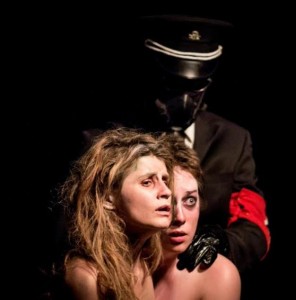 In a way it’s a brilliant and theatrical opening to an entertainment, an absolute tonal imposition that subjugates the collective will of its audience. That no other moment in the show matches the authority of this opening is a clue to what’s missing for me; another clue is in esoterica known to the initiate, that the flail is the gentlest of corporal disciplinary tools: lots of bark and little bite.
In a way it’s a brilliant and theatrical opening to an entertainment, an absolute tonal imposition that subjugates the collective will of its audience. That no other moment in the show matches the authority of this opening is a clue to what’s missing for me; another clue is in esoterica known to the initiate, that the flail is the gentlest of corporal disciplinary tools: lots of bark and little bite.
The most gratuitous of the hour’s not-quite-cathartic glimpses into hell is also the most literal illustration of the dramatic problem I have with this production. Lights up: A pair of nude, sobbing women clings together in mortal fear for a few seconds before a uniformed Nazi in a gas mask enters to drag one of them offstage: Lights out. Here is a classic case of disinterested proportion and its unfortunate result. It is a dramatic error to include a tangential element that overwhelms the moral weight inherent to the larger circumstance; the enormity of Nazism, for instance, wholly precludes the Holocaust as a vehicle for amusement.
Such at any rate is the classical position; of course, no less an interpreter of Americana than Steven Spielberg made Oskar Schindler into an Oscar-winning Mission: Impossible episode, and of course this vile bit will surely be someone’s favorite scenario of the evening. I think this trend is not only a moral but a social evil, a degradation of values the consequences of which are to be seen in the breakdown of civility in any city. Zombie Joe and Jana Wimer clearly are using this truth as a catalyst for Urban Death: A jaded population requires an ever-more-transgressive entertainment. Ten years of sold-out performances for an 11 o’clock show suggest that they are not entirely mistaken.
A theater artist who lived for seven years in Berlin, who married and divorced a German, who in her own theater sweated and bled to enlighten Germans and who now works to stimulate Americans, mused after seeing this show that it was not modern decadence but a Teuton-American cultural perversity that suggested in Urban Death a commonality with much of the theater she saw in the nation that engendered Luther’s Reformation, the Third Reich, and the most outrageous pornography outside of Japan. She saw in Urban Death, and in the devotion of its following, an incomplete maturity of vision – an admirable desire for impact hindered by a propagandic emotional fascism, an appeal to the black-and-white universe of Calvinist imperative. Thus one may describe the tastes of my nation three and a quarter centuries on from Salem.
Look at your television: images of death, of helpless women in sexual and mortal peril, are the foci of the predominant prime-time police procedural format in the most pervasive and pragmatic of marketplaces. Horror may not edify, but at this moment in American history it sells like nothing else. One can argue the artistic merits of any product. One cannot debate the fact of its popularity.
Urban Death was created as a distillation of the intentions of Zombie Joe’s Underground over a decade after the collective’s first productions in 1992, and as such the show represents some maturity of aesthetic vision. Certainly this spectacle is no accident. It’s impossible to watch it and remain unaffected. Much of its audience and many of its performers remain loyal participants from the original version. And its outreach, its appeal to young audiences with little prior interest in live theater, may be unparalleled in Los Angeles. At the very least, anyone who wants to attract a diverse theatrical audience ought to experience this show and do some hard thinking about the ramifications of its success.
photos by Marti Matulis; postcard design by Jana Wimer and Marti Matulis
Urban Death
Zombie Joe’s Underground Theatre Group
4850 Lankershim Boulevard in North Hollywood
Sat at 11 p.m.
ends on June 27, 2015
for tickets, call 818-202-4120 or visit www.ZombieJoes.Tix.com
for more info, visit www.ZombieJoes.com and www.UrbanDeath.com
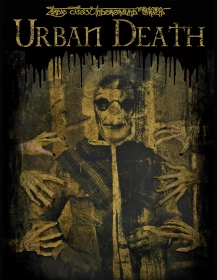
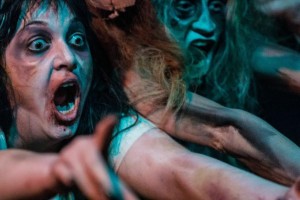
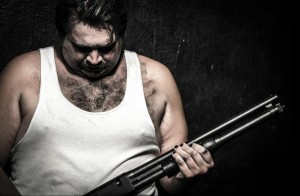
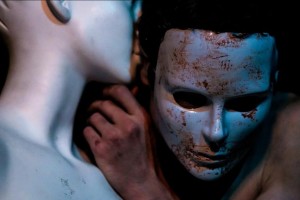
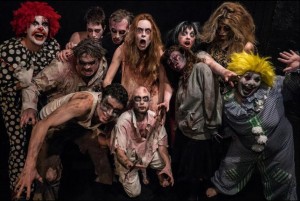
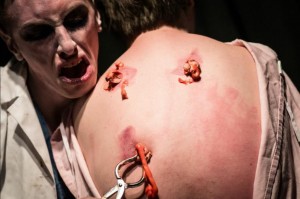


{ 2 comments… read them below or add one }
So this show isn’t about the demise of Tom Cruise’s ex-wife’s current spouse? LA culture is so confusing.
“who would pun would pick a pocket” – Pope